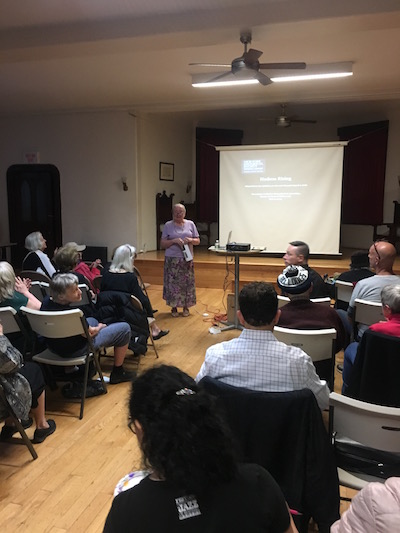BY MARK NIMAR | The Chelsea Waterside Park Association (CWPA) held its annual meeting on May 22, at St. Paul Lutheran Church in Chelsea. Founded in 1986, CWPA advocated for the creation of the Chelsea Waterside Park, a green space on W. 23rd St., near the Hudson River. The beloved neighborhood park contains a basketball court, a children’s play area, grassy lawns, and a dog run, all readily available to the public.
Engaged members of that public came out to the meeting, to show their support for Chelsea Waterside Park. Attendees included Democratic District Leader Steven Sykles-Mulligan, who praised CWPA as “a really integral part of this neighborhood, for a very long time. Some of the most active people in the community I know founded it… And these people were always looking to make improvements in the neighborhood, and to bring people together.”
He also noted the neighborhood “traditionally has had very few parks… There’s not really a lot of space to just hang out and enjoy the out-of-doors, so adding Chelsea Waterside Park to the neighborhood made a huge difference in the amount of green space that was available.”

The meeting’s main event was a presentation given by Deierde La Porte, a docent from the New York Historical Society. During the presentation, La Porte talked about the illustrious history of the Hudson River, starting with Henry Hudson’s first journey up the river in 1609.
La Porte cited several interesting facts about the Hudson’s history, such as its being the site of the first commercial steamboat ride, the fact that an estimated half of all the oysters in the world were once in New York Harbor, and how waterways like the Hudson and the Eerie Canal contributed to creating New York’s reputation as the Empire state. La Porte also noted, however, the darker side of the Hudson River’s history, by making the observation that although innovation moves society forward, “not all progress is positive.” Pollution and environmental damage often follow technological innovation, and these factors “can interfere with nature in a bad way,” she said.
La Porte cited the Hudson’s dead fishing industry as one such example of innovation’s negative effect on the river. Pollution in the Hudson caused DDT and mercury poisoning in fish, which killed the Hudson’s once-thriving fishing industry. La Porte also showed photos of cars piling up in the Hudson due to the damage of Hurricanes Sandy and Irene. Many scientists believe that humans’ negative influence on the environment has exacerbated the effects of hurricanes in recent years, and La Porte believes that the piling up of cars in the Hudson River is evidence of these negative effects.
Even the darker parts of the Hudson’s history, however, have a silver lining: La Porte noted that the Hudson’s pollution problem gave birth to the modern movement to save the environment. The Hudson’s visibility as one of America’s most important rivers inspired others around the country to take action, and limit the amount of pollution in their own communities.
Police Officer Gregory Edgar made an appearance, following La Porte’s presentation. Edgar is a Neighborhood Coordination Officer (NCO) for Chelsea’s 10th Precinct. An NCO’s job is to engage with residents in his district, so they can help solve the neighborhood’s issues. In his presentation, Officer Edgar touched on many different issues, such as staying safe at this year’s massive Pride march (which ends at Seventh Ave. and W. 23rd St.), the growing population at Hudson Yards, and security at Chelsea Waterside Park.
Community members have recently voiced concern about the presence of potentially dangerous people in the park, near children, and Edgar assured them that NYPD officers were “making their presence known” around the park.
Although security is a concern for Chelsea Waterside Park, the audience was more focused on the history, and significance, of Chelsea’s most important waterway.
“People should know basically the history of where they live,” said Community Board 4 member Allen Oster. “The Hudson River was an important part of the city, and especially this area, with the shipping, the seamen that worked here. There’s a big history to this neighborhood—the contributions that make for the advancement of the whole city, and the state, also. It’s important for people to know why all this is here.”

Chelsea Community News is made possible with the help of our awesome advertisers, and the support of our readers. If you like what you see, please consider taking part in our GoFundMe campaign (click here). To make a direct donation, give feedback about the site, or send a Letter to The Editor, email us at Scott@chelseacommunitynews.com.

Pingback: turkey tail mushrooms
Pingback: kojic acid soap
Pingback: pg slotเว็บตรง เกมพนันสุดฮอตฮิต ที่มาแรง
Pingback: คณิตศาสตร์ประกันภัย
Pingback: สมัครyehyeh
Pingback: 주식
Pingback: usdt지갑
Pingback: view website
Pingback: hop over to here
Pingback: online mushroom dispensary locations
Pingback: Chillwell AC reviews
Pingback: คาสิโนออนไลน์เว็บตรง
Pingback: สล็อตวอเลท ไม่มีขั้นต่ำ
Pingback: darkfox market url
Pingback: nova9
Pingback: dumps shop legit
Pingback: Instant Coffee